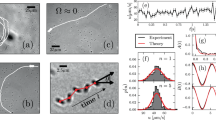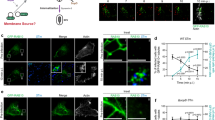Abstract
RUFFLES are specialized plasma membrane ultrastructures of mammalian cells thought to be integral to growth, development and locomotion1–4. Induced by growth factors5–8, mitogens9 or oncogene expression ruffles are sites of filamentous actin rearrangement7,8 and are temporally associated with enhanced pinocytosis10,12. But the function of ruffles, their mechanism of induction and their role in pinocytosis are not understood. We have observed formation of structures resembling ruffles associated with the site of entry of invasive Salmonella typhimurium 13. Here we report that ruffles elicited by invasive Salmonella directly mediate internalization of non-invasive bacteria in a macropinocytotic fashion, a phenomenon we term 'passive entry'. Furthermore, ruffles induced in the absence of Salmonella also facilitate passive entry. We present evidence that ruffles, common to many signalling events, comprise the macropinocytotic machinery mediating pinocytosis and are subverted by Salmonella so as to enter mammalian cells.
This is a preview of subscription content, access via your institution
Access options
Subscribe to this journal
Receive 51 print issues and online access
$199.00 per year
only $3.90 per issue
Buy this article
- Purchase on Springer Link
- Instant access to full article PDF
Prices may be subject to local taxes which are calculated during checkout
Similar content being viewed by others
References
Misumi, Y. & Akiyoshi, T. Am. J. Anat. 191, 419–428 (1991).
Trinkaus, J. P. Expl biol. Med. 10, 130–173 (1985).
Abercrombie, M. Expl Cell Res. 8 (suppl.), 188–198 (1961).
Heath, J. P. & Holifield, B. F. Cell Mot. Cytoskel. 18, 245–257 (1991).
Chinkers, M., McKanna, J. A. & Cohen, S. J. Cell Biol. 83, 260–265 (1979).
Goshima, K., Masuda, A. & Owaribe, K. J. Cell Biol. 98, 801–809 (1984).
Kadowaki, T. et al. J. biol. Chem. 261, 16141–16147 (1986).
Mellström, K., Heldin, C.-H. & Westermark, b. Expl Cell Res. 177, 347–359 (1988).
Miyata, Y., Nishida, E. & Sakai, H. Expl Cell Res. 175, 286–297 (1988).
Bar-Sagi, D. & Feramisco, J. R. Science 233, 1061–1068 (1986).
Ridley, A. J., Paterson, H. F., Johnston, C. L., Diekmann, D. & Hall, A. Cell 70, 401–410 (1992).
Haigler, H. T., McKanna, J. A. & Cohen, S. J. Cell Biol. 83, 82–90 (1979).
Francis, C. L., Starnbach, M. N. & Falkow, S. Molec. Microbiol. 6, 3077–3087 (1992).
Jackowski, M. M., Swift, L. L., Cohen, S. & McKanna, J. A. J. cell. Physiol. 142, 458–468 (1990).
Yahara, I., Harada, F., Sekita, S., Yoshihira, K. & Natori, S. J. Cell Biol. 92, 69–78 (1982).
Finlay, B. B. & Falkow, S. Biochimie 70, 1089–1099 (1988).
Lee, C. A., Jones, B. D. & Falkow, S. Proc. natn. Acad. Sci. U.S.A. 89, 1847–1851 (1992).
Labigne-Roussel, A. F., Lark, D., Schoolnik, G. & Falkow, S. Infect. Immun. 46, 251–259 (1984).
Lee, C. A. & Falkow, S. Proc. natn. Acad. Sci. U.S.A. 87, 4304–4308 (1990).
Hull, R. A., Gill, R. E., Hsu, P., Minshew, B. H. & Falkow, S. Infect. Immun. 33, 933–938 (1981).
Siraganian, R. P. et al. Fedn Proc. 41, 30–34 (1982).
Pfeiffer, J. R., Seagrave, J. C., Davis, B. H., Deanin, G. G. & Oliver, J. M. J. Cell Biol. 101, 2145–2155 (1985).
Ullrich, A. & Schlessinger, J. Cell 61, 203–212 (1990).
Galán, J. E. Pace, J. & Hayman, M. J. Nature 357, 588–589 (1992).
Ginocchio, C., Pace, J. & Galán, J. E. Proc. natn. Acad. Sci. U.S.A. 89, 5976–5980 (1992).
Pruss, R. M. & Herschman, H. R. Proc. natn. Acad. Sci. U.S.A. 74, 3918–3921 (1977).
Schneider, C. A., Lim, R. W., Terwilliger, E. & Herschman, H. R. Proc. natn. Acad. Sci. U.S.A. 83, 333–336 (1986).
Honegger, A. M., Kris, R. M., Ullrich, A. & Schlessinger, J. Proc. natn. Acad. Sci. U.S.A. 86, 925–929 (1989).
Spaargaren, M., Defize, L. H. K., Boonstra, J. & de Laat, S. W. J. biol. Chem. 266, 1733–1739 (1991).
Isberg, R. R., Voorhis, D. L. & Falkow, S. Cell 50, 769–778 (1987).
Author information
Authors and Affiliations
Rights and permissions
About this article
Cite this article
Francis, C., Ryan, T., Jones, B. et al. Ruffles induced by Salmonella and other stimuli direct macropinocytosis of bacteria. Nature 364, 639–642 (1993). https://doi.org/10.1038/364639a0
Received:
Accepted:
Issue Date:
DOI: https://doi.org/10.1038/364639a0
This article is cited by
-
Murine AML12 hepatocytes allow Salmonella Typhimurium T3SS1-independent invasion and intracellular fate
Scientific Reports (2021)
-
Type three secretion system in Salmonella Typhimurium: the key to infection
Genes & Genomics (2020)
-
Role of the microbiome in occurrence, development and treatment of pancreatic cancer
Molecular Cancer (2019)
-
CYRI/FAM49B negatively regulates RAC1-driven cytoskeletal remodelling and protects against bacterial infection
Nature Microbiology (2019)
-
Plasticity of the brush border — the yin and yang of intestinal homeostasis
Nature Reviews Gastroenterology & Hepatology (2016)
Comments
By submitting a comment you agree to abide by our Terms and Community Guidelines. If you find something abusive or that does not comply with our terms or guidelines please flag it as inappropriate.



